Business management is the process of planning, organizing, and controlling a company’s operations, resources, and personnel to achieve its goals efficiently. It involves crucial functions like strategic planning, organizing resources, leading teams, and controlling operations. Business managers make decisions about finances, marketing, HR, technology, and more to guide the organization’s strategy and optimize performance.
Effective business management is essential for organizations of all types to organize activities in an efficient way that promotes growth and success.
Dive in to learn more about the key elements, types, styles, and career opportunities in this dynamic field.
What is Business Management?
Business management is the process of planning, organizing, and controlling a company’s operations, resources, and personnel to achieve its goals efficiently. It involves crucial functions like strategic planning, organizing resources, leading teams, and controlling operations. Business managers make decisions about finances, marketing, HR, technology, and more to guide the organization’s strategy and optimize performance.
Effective business management requires strong leadership abilities, problem-solving skills, and communication expertise. You need to be able to confidently use different communication channels as well, whether that’s email providers or mass texting apps or team chat apps like Slack.
Managers must be able to adapt to evolving conditions inside and outside the organization over time. They carry responsibility for critical choices that impact budgets, processes, staffing, and infrastructure in order to meet objectives.
Training focused on organizational resilience can enhance adaptability by equipping managers with the skills to navigate uncertainty, lead through change, and maintain stability under pressure.
Management skills training is essential to develop these competencies, ensuring that managers can effectively navigate challenges and drive organizational success.
While technical expertise in a field is important, managers must also utilize ‘soft skills’ to resolve conflicts, connect with staff, and foster a positive culture.
Business management is essential for organizations of all types to organize activities in an efficient way that promotes growth and success.
Key Elements of Business Management
The main functions of business management include planning, organizing, leading, and controlling.
- Planning involves establishing goals and strategies to achieve them through strategic, tactical, and operational plans.
- Organizing structures tasks, teams, roles, and responsibilities to execute plans.
- Leading refers to guiding teams by communicating vision, motivating, directing, coaching, and supporting employees using interpersonal skills to rally and inspire.
- Controlling oversees operations, monitors progress, evaluates performance to reach goals, and takes corrective actions when needed.
Let’s break each function in more detail-
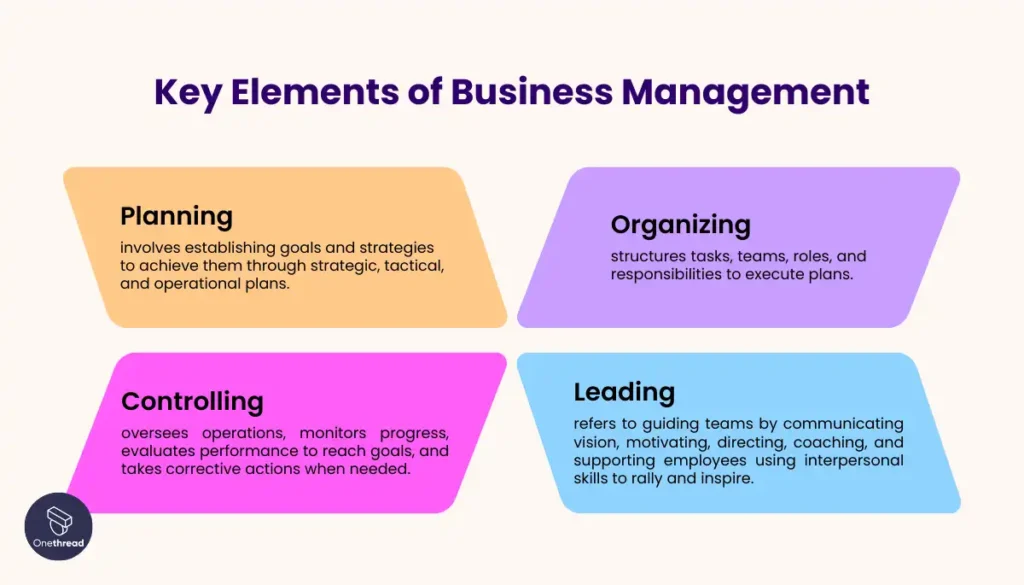
Planning
Planning involves setting goals, creating strategies to achieve them, and allocating resources. A crucial aspect of this process is financial planning for a small business, ensuring that financial resources are effectively managed to support strategic objectives. It is done at multiple levels – strategic (long-term, big-picture), tactical (mid-range objectives), and operational (day-to-day activities). Good plans consider challenges, opportunities, timelines, and budgets. Planning works best when managers collaborate with employees in strategy development.
Organizing
Organizing structures and available resources to accomplish plans. It involves assigning tasks, setting authority levels, and coordinating teams and departments. As businesses change, organizing must be adjusted – adding staff, realigning departments, and updating processes. Effective organizing facilitates communication and collaboration for efficient operations.
Leading
Leading refers to managing people – motivating, directing, and communicating with employees. Good leadership provides vision, clarity, support, and empowerment to teams. Leading utilizes various interpersonal skills to bring out the best in people. Different situations call for different leadership approaches – directing, coaching, supporting, or delegating.
Controlling
Controlling oversees operations to ensure goals are met as planned. It monitors performance, budgets, and deadlines and makes corrections when needed – addressing underperforming staff or reallocating resources. Controlling measures progress analytically against standards and takes preventative or corrective action. Record-keeping and reporting provide data to inform operational improvements.
How Does Business Management Work?
Here is an example of walking through the four management functions in a real-life scenario:
- Step 1: Planning
A retail clothing store manager does sales forecasting and sets a goal to increase revenue by 10% this year. She plans to open an e-commerce store and add new product lines to accomplish this.
- Step 2: Organizing
The manager structures her staff by hiring a web developer to create the e-commerce site, assigning sales associates to manage the new products, and expanding the marketing team to promote the website and new merchandise.
- Step 3: Leading
The manager rallies her department heads, providing clarity on the growth vision and new sales objectives. She oversees training on the new processes and technology, motivating teams to drive success.
- Step 4: Controlling
The manager tracks daily sales figures, web traffic, and inventory levels. When some new products underperform, she makes pricing adjustments and shifts marketing budgets to better-performing areas. By correcting course as needed, the overall year-end revenue goal is achieved.
This example shows how the management functions might progress in a typical business scenario – planning the growth goal, organizing staff and resources to support it, leading teams during the transition, and controlling operations to stay on track. The linkage of strategy across the functions illustrates the integrated nature of management.
Business management is applicable to various types of organizations, including corporations, small businesses, non-profit organizations, and government agencies. Managers at different levels, such as top-level executives, middle managers, and supervisors, oversee different aspects of the business and ensure its success.
Now, let’s find out different business types with their definitions.
Business Management Definition by Business Types
Although the core management fundamentals remain almost the same for all types of business, their definitions vary a little due to their different operational dissimilarities.
What is Global Business Management?
Global business management refers to overseeing international company operations across multiple countries, adapting strategy and functions like marketing, supply chains, and human resources to diverse cultures, policies, and regulations.
It includes navigating complexities such as company’s registration in different jurisdictions, ensuring compliance with local business laws and customs.
What is International Business Management?
International business management involves leading organizational strategy, functions, and resource allocation for operations spanning multiple countries. It requires adapting to different cultures, laws, markets, and trade policies.
What is Small Business Management?
Small business management refers to the oversight of operations, budgets, personnel, and growth strategy for businesses with just a few employees filling core roles in a cost-efficient way.
What is Drug Store Business Management?
Drug store business management encompasses the leadership and coordination of retail pharmacy and convenience store locations, focusing on regional expansion, inventory and supply chains, and delivering health products.
What is Agriculture Business Management?
Agriculture business management deals with the oversight of farming operations from cultivation to distribution, managing crop cycles, machinery, storage, and sales channels, and responding to policy, regulations, and climate factors.
What is Sports Business Management?
Sports business management involves directing strategy for sports teams, leagues, media partnerships, events, facilities, and merchandise, applying business principles while balancing fan engagement and competitive success.
What is Farm Business Management?
Farm business management focuses on planning, budgeting, account management, and long-term improvements for agricultural operations, overseeing livestock, equipment, crop cultivation, staff, and regulatory compliance.
What is General Business Management?
General business management refers to the broad administration of an organization’s operations, resources, budgets, and personnel to ensure coordination across departments and progress toward the company’s objectives.
After understanding different business management types, it’s crucial to recognize its significance within an organization.
Importance of Business Management
Business management is important for a company’s smooth operation and success. It provides planning, organization, and control that ensures efficient workflows, clear communication, and well-defined processes. This leads to improved productivity and reduced wasted resources.
Furthermore, business management supplies direction and guidance to motivate employees, align activities with organizational strategy, and adapt to changing environments. Without proper management, companies would struggle to function, achieve goals, or remain competitive in dynamic markets.
Benefits of Proper Business Management
The benefits of business management are the tangible improvements and gains companies experience from effective management practices. This includes increased profitability since streamlining operations and better financial decisions lead to higher profits. It also includes improved efficiency as organized workflows and clear communication increase productivity and reduce wasted resources.
Additionally, business management enhances employee satisfaction through positive culture and growth opportunities, creating a happier and more motivated workforce.
In summary, the key benefits are improved finances, productivity, and workforce engagement – all contributing to success. Proper business management directly creates these advantageous outcomes.
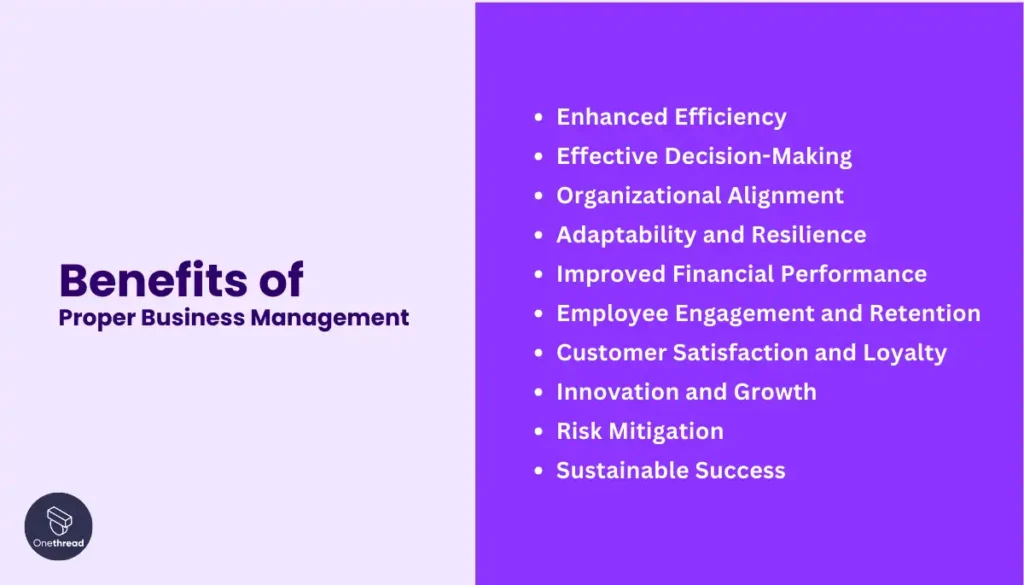
- Enhanced Efficiency: Proper business management ensures streamlined operations, optimized processes, and effective resource allocation, leading to improved efficiency and productivity.
- Effective Decision-Making: With sound business management practices in place, leaders can make informed decisions based on accurate data, market insights, and strategic analysis, resulting in better outcomes.
- Organizational Alignment: Proper business management fosters alignment between goals, strategies, and actions across different departments, ensuring everyone is working towards a shared vision.
- Adaptability and Resilience: Effective management equips businesses to navigate challenges and changes in the market by fostering adaptability, resilience, and the ability to seize opportunities.
- Improved Financial Performance: Strong business management practices enable effective financial planning, budgeting, and cost control, leading to improved profitability and financial stability.
- Employee Engagement and Retention: Proper management creates a positive work environment, fosters employee engagement, recognizes talent, and promotes professional growth, resulting in higher job satisfaction and employee retention.
- Customer Satisfaction and Loyalty: Through efficient client management, businesses can consistently deliver high-quality products and services, resulting in increased customer satisfaction, loyalty, and positive brand reputation.
- Innovation and Growth: Effective management encourages a culture of innovation, fosters creativity, and nurtures entrepreneurial thinking, enabling businesses to drive growth and stay ahead of the competition.
- Risk Mitigation: Proper management practices include risk assessment, mitigation strategies, and contingency planning, minimizing potential threats and ensuring business continuity.
- Sustainable Success: By implementing proper business management, organizations can achieve long-term success, sustainable growth, and a solid foundation for future expansion and development.
Business management encompasses various approaches and methodologies tailored to different organizational needs. Let’s explore some common types of business management with examples.
Types of Business Management With Examples
There are various types of business management approaches that organizations adopt based on their goals, industry, and internal dynamics. Here are some commonly recognized types of business management:
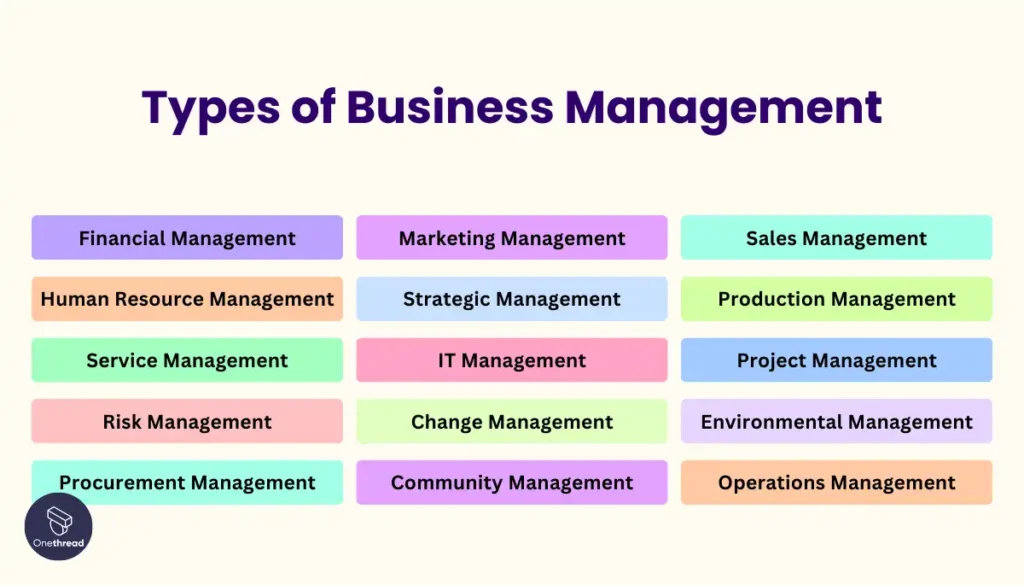
Financial Management
Financial management encompasses activities related to managing the organization’s financial resources. It includes budgeting, financial planning, investment decisions, and financial analysis to ensure financial stability and growth.
Financial management software can play a crucial role in streamlining these processes and enhancing accuracy.
Example: The CFO oversees the budgeting, planning, reporting, and analysis of all financial data to manage profits, cash flow, and growth opportunities.
Marketing Management
Marketing management focuses on promoting products or services, identifying target markets, and building strong customer relationships. It involves market research, branding, advertising, pricing, and developing marketing strategies to drive sales and customer loyalty.
Example: The VP of Marketing sets branding guidelines, manages advertising campaigns, analyzes customer data, and oversees social media to build brand awareness and loyalty.
Sales Management
Sales management is about driving an organization’s sales activities and overseeing the sales team. This involves recruiting and training salespeople, establishing sales targets and quotas, analyzing sales data, and implementing sales strategies to boost revenue. It also includes motivating and supporting sales reps, planning sales operations, and forecasting future sales.
Example: The Sales VP monitors rep performance metrics, designs sales incentive programs, analyzes trends, and adjusts regional targets to motivate the team to drive revenues.
Human Resource Management
Human resource management involves managing the organization’s workforce. It includes tasks such as recruitment, training, performance management, employee relations, and creating a positive work culture.
Example: The HR department leads recruiting, onboarding, training, payroll and maintaining workplace culture to acquire and retain talented staff across the organization.
Strategic Management
This type of management focuses on long-term planning and setting the overall direction of the organization. It involves analyzing the competitive landscape, identifying opportunities, and developing strategies to achieve sustainable growth and competitive advantage.
Example: The CEO defines long-term goals, and analyzes trends and industry shifts to identify growth opportunities to gain competitive advantage.
Production Management
Production management focuses on the operation and control of manufacturing processes that convert raw materials into finished goods. This involves planning, scheduling, supervising, storing, and controlling materials, inventory, machines, and production activities to ensure efficient workflow and optimal resource utilization.
Example: The VP of Manufacturing oversees factory workflow, machinery, quality control, supply chain coordination, and labor cost analysis to optimize the fabrication of private label products.
Service Management
Service management involves coordinating and overseeing various interconnected activities that comprise a service. This requires conceptualizing, designing, delivering, supporting, and improving end-to-end services to ensure seamless customer experiences and meet business objectives. One key approach is leveraging chatbot technology to automate customer interactions, handle common inquiries, and support more efficient service delivery. By utilizing the best chatbot builders, companies can develop tailored chatbot solutions that integrate into help desk systems, product return processes, and loyalty programs, ensuring seamless, positive customer experiences.
Example: The Customer Service department designs help desk systems, product return processes, and loyalty programs, often incorporating chatbot solutions to provide instant support, streamline processes, and enhance overall customer satisfaction. This ensures seamless, positive customer experiences while improving service efficiency.
IT Management
IT management deals with all technology resources and activities within an organization. This covers planning, coordinating, controlling, and leading the acquisition, development, maintenance, and use of information technology tools to achieve business goals and gain a competitive advantage.
Incident response planning is another crucial aspect of IT management. Developing a comprehensive incident response strategy ensures swift and effective action when security breaches occur, minimizing potential damage and downtime.
Example: The CIO oversees software development, cybersecurity measures, data storage systems, and tech support to leverage technology to enhance productivity and data safety.
Project Management
Project management focuses on leading the work of a team to achieve all project goals within given constraints like scope, time, and budget. This involves planning project activities, securing resources, delegating tasks, monitoring progress, overseeing quality, mitigating risks, and completing deliverables according to plan.
Example: The PMO utilizes tools like Gantt charts, risk registers, and status reports to plan and execute initiatives like new store openings within budget and designated timelines.
You can find different tools on this website (plagiarism checker, paraphraser, AI detector, etc.)
Risk Management
Risk management involves identifying, assessing, and prioritizing risks to minimize, monitor, and control the probability or impact of unfortunate events. This requires analyzing exposures, implementing risk control strategies, and specifying resources to provide reasonable assurance for achieving objectives.
Example: The Risk Manager oversees policy compliance, audits processes, assesses systems, and develops contingency plans to mitigate brand, legal, and data vulnerabilities.
Change Management
Change management refers to the process of managing change to achieve a desired outcome. It involves establishing strategies and plans, communicating shifts in policy or procedure, securing stakeholder commitment, providing training, reinforcing changes, and evaluating progress for long-term change optimization.
Example: The Change Management Lead clearly communicates upcoming initiatives, trains staff on new systems, and regularly follows up to ensure workplace changes are adopted smoothly.
Environmental Management
Environmental management deals with the impacts of human activities on the environment through sustainable practices. This involves establishing policies, setting targets, implementing programs, monitoring progress, and fostering continuous improvement to mitigate ecological issues and keep environmental impacts under control.
Example: The Sustainability Lead tracks energy usage, waste production, packaging, and recycling to minimize ecological footprint through LEED certified buildings and renewable energy.
Procurement Management
Procurement management focuses on acquiring goods, services, or works from external sources. This involves procurement planning, vendor selection, contract management, purchasing, inventory management, and performing quality assurance to obtain the best value when outsourcing expertise or buying raw materials.
Utilizing vendor management software can significantly streamline these processes, ensuring efficient and effective interactions with suppliers.
Additionally, procurement management software enhances these efforts by automating and optimizing tasks, allowing procurement teams to track and manage every stage of the acquisition process with greater accuracy and efficiency.
Example: The Sourcing Manager vets suppliers, negotiates contracts, oversees purchase order systems, and manages inventory to acquire quality materials and services at optimal cost.
Community Management
Community management entails building, nurturing, and managing an online community to facilitate connections. This involves establishing guidelines, encouraging participation, mediating interactions, sharing relevant content, providing support, and analyzing data to create a welcoming space for collaboration or discussion.
Example: The Community Manager fosters customer engagement by moderating discussion forums and social media, sharing special offers and surveys, and monitoring feedback to understand customer needs.
Operations Management
Operations management focuses on the efficient production and delivery of goods and services. It involves optimizing processes, managing resources, and ensuring smooth operations to meet customer demands while minimizing costs.
Example: The COO analyzes supply chain bottlenecks, production capacity, inventory levels, and distribution networks to ensure efficient, on-time delivery of products to stores and customers.
These are just a few examples, and it’s important to note that different organizations may combine or adapt these management approaches based on their unique needs and circumstances.
Effective business management requires a systematic and structured approach to coordinate and align various organizational components.
Business Management System
A business management system refers to a set of processes, tools, and practices designed to streamline and optimize various aspects of business operations. It provides a structured framework for managing different functions and helps organizations achieve their goals efficiently.
Incorporating the best WhatsApp chatbot into a business management system can further enhance communication and customer engagement. This integration allows businesses to automate customer interactions, improve response times, and provide a seamless user experience, all within a single, efficient platform.
Additionally, the use of conversion rate optimization tools within a business management system can significantly improve the effectiveness of online marketing campaigns and digital interactions. By analyzing user behavior and refining strategies accordingly, these tools help businesses increase the likelihood of converting casual visitors into loyal customers, thereby boosting overall performance.
According to a report by Forbes, a whopping 54% of enterprises acknowledged the indispensable role of cloud-based Business Intelligence (BI) in both their present operations and future initiatives. It highlights the growing recognition among organizations of the immense value that cloud-based BI brings to the table.
Here are some key components of a business management system:
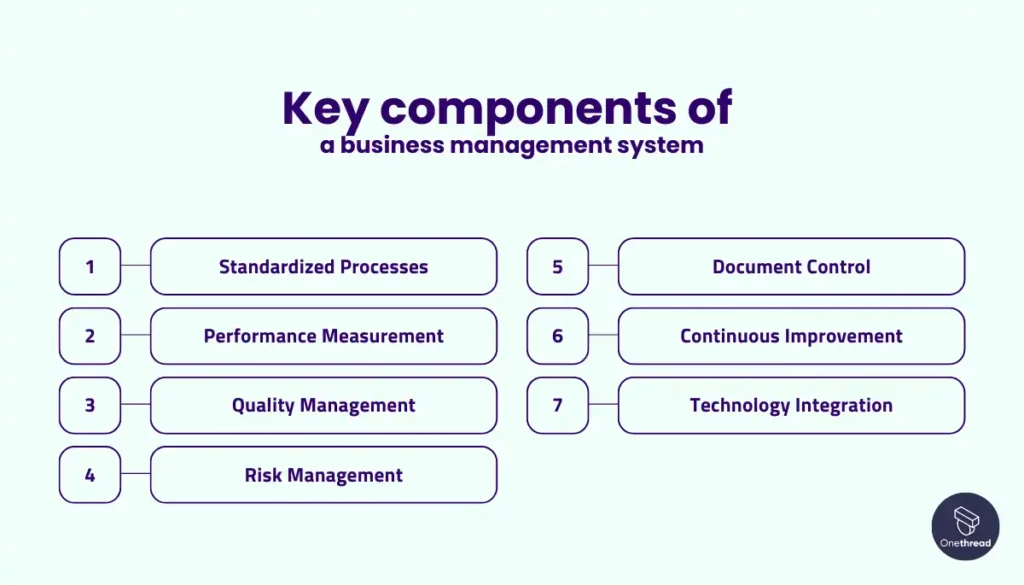
Standardized Processes
A business management system establishes standardized processes across the organization, ensuring consistency and efficiency in operations. This includes defining workflows, documenting procedures, and implementing best practices.
Performance Measurement
It involves implementing performance metrics and Key Performance Indicators (KPIs) to measure progress toward goals, track performance, and identify areas for improvement.
Quality Management
Quality management systems are an integral part of a business management system, ensuring that products or services meet customer requirements and comply with industry standards. This includes implementing quality control measures, conducting audits, and continuously improving processes.
Risk Management
A business management system incorporates risk management practices to identify and mitigate potential risks that could impact the organization’s performance or reputation. This includes risk assessment, contingency planning, and implementing controls to minimize risks.
Document Control
Document control ensures the proper management of important documents and records within the organization. This includes version control, document storage, retrieval processes, and adherence to regulatory requirements.
Continuous Improvement
A business management system promotes a culture of continuous improvement by encouraging feedback, conducting regular evaluations, and implementing strategies to enhance processes and performance.
Technology Integration
Many business management systems leverage technology to automate processes, improve efficiency, and enable better data management and analysis. This can involve using software applications, enterprise resource planning (ERP) systems, or customer relationship management (CRM) tools.
Consider using project management software like Onethread for seamless technology integration. Onethread offers features like task management, communication tools, and document sharing, all in one centralized platform. This streamlines workflows, improves collaboration, and ensures everyone has easy access to the latest information.
Try Onethread
Experience Onethread full potential, with all its features unlocked. Sign up now to start your 14-day free trial!
The specific components and structure of a business management system can vary depending on the organization’s size, industry, and specific requirements. It provides a comprehensive framework for managing the organization’s operations effectively, improving performance, and driving overall success.
Managers can adopt different leadership styles and approaches to business management, each with its own advantages and considerations.
Different Business Management Styles: The Way to Do Business
Business management styles refer to how managers lead their teams. There are many types, like autocratic (the boss makes all decisions), democratic (the team provides input), laissez-faire (hands off), coaching (focused on development), etc. Each has pros and cons. Effective managers adapt their style to the situation and needs of their team in order to set clear expectations, encourage participation and growth, and ultimately drive results.
The best managers balance guidance with autonomy and care about both short-term outputs and long-term outcomes.
Here are some common management styles:
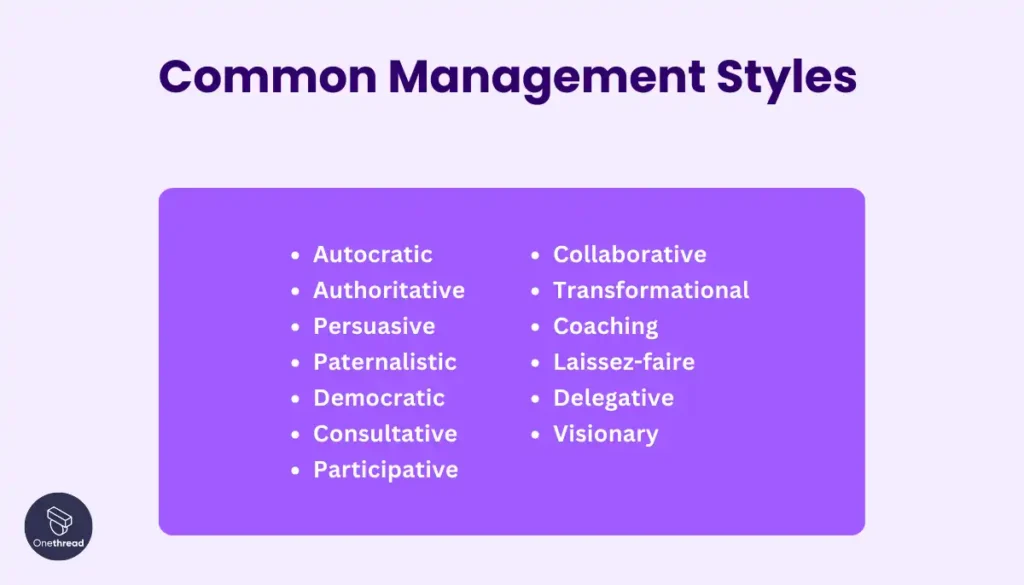
Autocratic
Autocratic management style follows a top-down approach, with one-way communication from bosses to employees. Managers make all decisions without input from staff. Employees are treated as drones and monitored closely within defined roles. Staff cannot question or improve processes.
Best for: Crisis situations and industries like manufacturing where quick decisions and consistency are crucial.
Not suitable for: Creative fields or companies focused on innovation, as it stifles new ideas.
- Pros: Fast decisions, clear expectations
- Cons: Lack of engagement and innovation, high turnover
Authoritative
In the authoritative management style, managers dictate what subordinates must do and punish noncompliance. Employees must follow orders without questioning authority or deviating from set procedures. Managers closely micromanage staff, believing that without supervision employees will not succeed.
Best for: Unskilled workers who require structure and direct supervision.
Not Suitable for: Knowledge workers, creative roles, or cultures valuing collaboration, as it kills morale and innovation.
- Pros: Clear expectations
- Cons: Poor morale, high turnover, lack of creativity
Persuasive
The persuasive management style involves managers using persuasive skills to convince staff that the unilateral decisions implemented are for the team/company’s good. Managers invite questions and explain the rationale behind policies. This can increase trust and make employees feel more valued in key decisions.
Best for: Inexperienced teams requiring direction from an expert manager with more knowledge.
Not Suitable for: Experienced teams where the manager should collaborate rather than persuade top-down.
- Pros: Higher trust, easier acceptance of decisions
- Cons: Lack of input can still frustrate employees
Paternalistic
In the paternalistic style, managers make unilateral decisions but explain they are acting from a place of expertise and legitimacy. Decisions are explained to staff but without collaboration or questioning. Managers focus on employee welfare, basing choices on what is best for their team.
Best for: Small, family-oriented cultures already embracing the “company as family” mentality.
Not Suitable for: Large or modern organizations with an egalitarian, performance-driven culture.
- Pros: Focus on employee well-being
- Cons: Overly dependent employees, potential resentment
Democratic
Democratic managers encourage employees to provide input in decision-making, but ultimately the manager decides. Communication goes both top-down and bottom-up. Diverse opinions and ideas inform decisions and increase team cohesion.
Best for: Teams and cultures that value collaboration, diverse perspectives, and empowerment.
Not Suitable for: Environments requiring quick unilateral decisions like emergency services.
- Pros: Increased engagement, creativity, innovation
- Cons: Slow decision-making process
Consultative
Consultative managers ask for the team’s opinions and thoughts, consulting every member’s viewpoint. The manager makes the final decision but considers all information from staff first. This builds trust and helps management grow by learning from employees.
Best for: Experts managing specialized teams to tap insights.
Not Suitable for: Inexperienced managers or tactical execution-focused teams.
- Pros: Builds trust, and upskills managers
- Cons: Time intensive, perceived favoritism
Participative
In participative management, managers and staff are active in the decision process. Staff access more company information and are pushed to innovate solutions. Management seeks opinions, co-decides with staff, and the company acts.
Best for: Change management and driving innovation by aligning staff with company goals.
Not Suitable for: Hierarchical cultures or industries unable to share information widely.
- Pros: Increased engagement and motivation
- Cons: Slow, risks of sharing sensitive info
Collaborative
Collaborative managers create open forums for extensive discussion before deciding based on majority rule. The staff takes ownership of outcomes, increasing engagement, innovation, and creativity.
Best for: Organizations focused on creativity, problem-solving, and employee engagement as strategic priorities.
Not Suitable for: Results-driven cultures with tight deadlines needing decision efficiency.
- Pros: High engagement and creativity
- Cons: Time-consuming, majority rules aren’t always best
Transformational
Transformational managers focus on pushing staff to greater accomplishments through encouragement and motivation. Managers inspire performance by demonstrating a strong work ethic themselves. Innovation and adaptability are increased.
Best for: Startups and companies in fast-changing industries like tech that need constant innovation.
Not Suitable for: Established companies focused on consistent execution of an existing business model.
- Pros: Innovation and adaptation
- Cons: Risk of burnout
Coaching
In the coaching style, managers see themselves as coaches and employees as their team. Their focus is employees’ development, putting professional growth first. They prioritize long-term development over short-term failures, promoting upskilling and learning.
Best for: Roles focused on developing talents like HR and L&D managers.
Not Suitable for: Operations or sales managers who need to prioritize short-term results.
- Pros: Engaged, valued employees
- Cons: Toxic environments, short-term projects suffer
Laissez-faire
Laissez-faire managers take a hands-off approach. Staff is trusted to work without supervision and control decisions. Managers assign work and review final outcomes but otherwise remain uninvolved unless staff requests help.
Best for: Self-motivated and autonomous teams of experts.
Not Suitable for: Junior team members who require more hands-on training, support, and oversight.
- Pros: Innovation and autonomy
- Cons: Lack of productivity and direction
Delegative
Delegative managers assign tasks and then empower staff to complete work as they see fit. Managers review work after completion and give advice for improvement but otherwise remain uninvolved throughout the process.
Best for: Decentralized organizations with employees more expert than managers.
Not Suitable for: Tactical teams in need of consistent guidelines and synchronization.
- Pros: Creativity and problem-solving
- Cons: Lack of uniformity and resentment
Visionary
Visionary managers lead by inspiring staff towards their vision. After explaining goals and the reasons behind them, managers allow freedom to achieve tasks with minimal involvement, just periodic check-ins. Lots of feedback and praise is provided.
Best for: Purpose-driven organizations like non-profits with inspired cultures.
Not Suitable for: Numbers-focused companies where inspiration matters less than concrete results.
- Pros: Engagement and satisfaction
- Cons: Hard to fake inspiration
Regardless of the management style, Onethread can empower managers and teams. Its features like role-based permissions, task delegation, and progress tracking can support different leadership approaches while ensuring clear communication, accountability, and alignment with overall goals.
Try Onethread
Experience Onethread full potential, with all its features unlocked. Sign up now to start your 14-day free trial!
Now, let’s find out some great business management strategies for successful management implementation.
Different Business Management Strategies
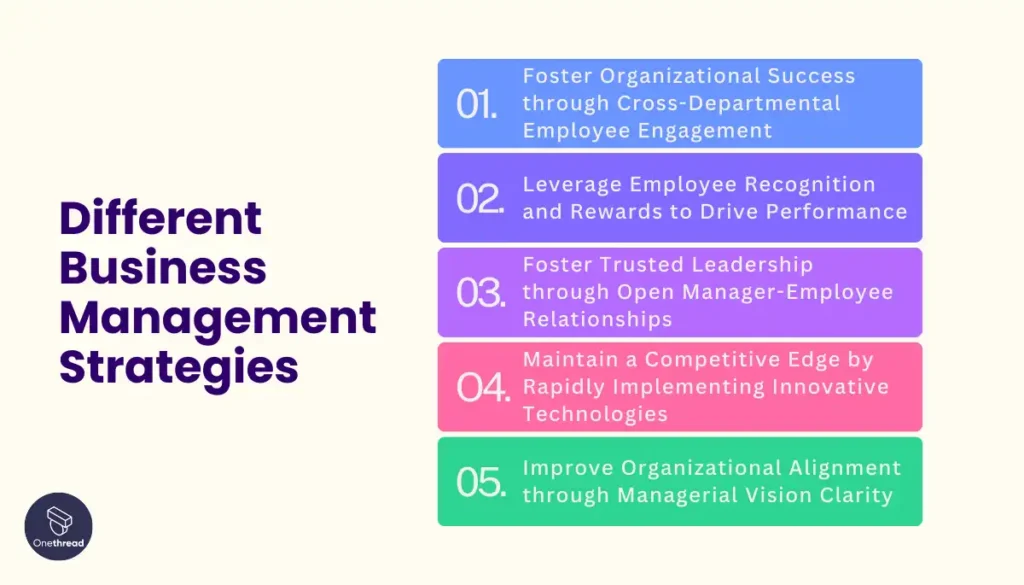
The following tactics are proven and can make your management process way smoother if implemented properly.
1. Foster Organizational Success through Cross-Departmental Employee Engagement
Engaging team members from every department is crucial for success. A motivated, enthusiastic workforce helps achieve business goals better than disengaged employees just working for a paycheck. Engaged employees feel valued and are driven to contribute more.
Foster cross-departmental collaboration and engagement through Onethread’s centralized platform. Team members from all departments can easily share information, collaborate on projects, and stay up-to-date on progress, leading to a more cohesive and successful organization.
2. Leverage Employee Recognition and Rewards to Drive Performance
Recognizing and rewarding employees who contribute to business growth boosts their motivation. Rewards can be praise, small gifts, bonuses, etc. Appreciated employees feel valued, impacting others positively. Money can’t replace the feeling of being recognized.
Track employee contributions and achievements within Onethread. This allows for timely recognition and reward distribution, further boosting employee morale and motivation, and ultimately driving performance.
3. Foster Trusted Leadership through Open Manager-Employee Relationships
Closed-off managers struggle to build team trust. Being open and sharing ideas on business direction makes employees feel trusted, boosting morale. An unapproachable boss negatively impacts productivity and the company’s future.
Onethread’s communication features like task comments and discussions can foster open communication and information sharing between managers and employees. This transparency builds trust and strengthens relationships within the team.
4. Maintain a Competitive Edge by Rapidly Implementing Innovative Technologies
Quickly adapting to the latest industry technologies shows customers and employees the business’s commitment to progress. Having user-friendly digital channels allows serving customers anytime. To stay ahead, managers must adopt cutting-edge tech tools.
Onethread itself is an innovative project management solution that can help organizations streamline processes, improve collaboration, and boost efficiency. By adopting Onethread, businesses can demonstrate their commitment to progress and stay ahead of the curve.
5. Improve Organizational Alignment through Managerial Vision Clarity
Many businesses fail due to managers lacking clarity on the company’s vision, mission, and how to achieve goals. Organizations should ensure managers understand the company’s purpose, current priorities, and individual responsibilities for cohesive goal alignment.
Onethread’s project management tools can help translate the company’s vision and goals into actionable plans and tasks. This improves understanding and alignment among all levels of the organization, leading to more focused and effective efforts toward achieving goals.
Try Onethread
Experience Onethread full potential, with all its features unlocked. Sign up now to start your 14-day free trial!
While the specific practices may vary across industries and organizations, there are certain widely accepted best practices that can contribute to effective business management.
Best Business Management Practices
While there isn’t a one-size-fits-all answer to the best business management tactics, here are some widely recognized strategies that can contribute to effective management:
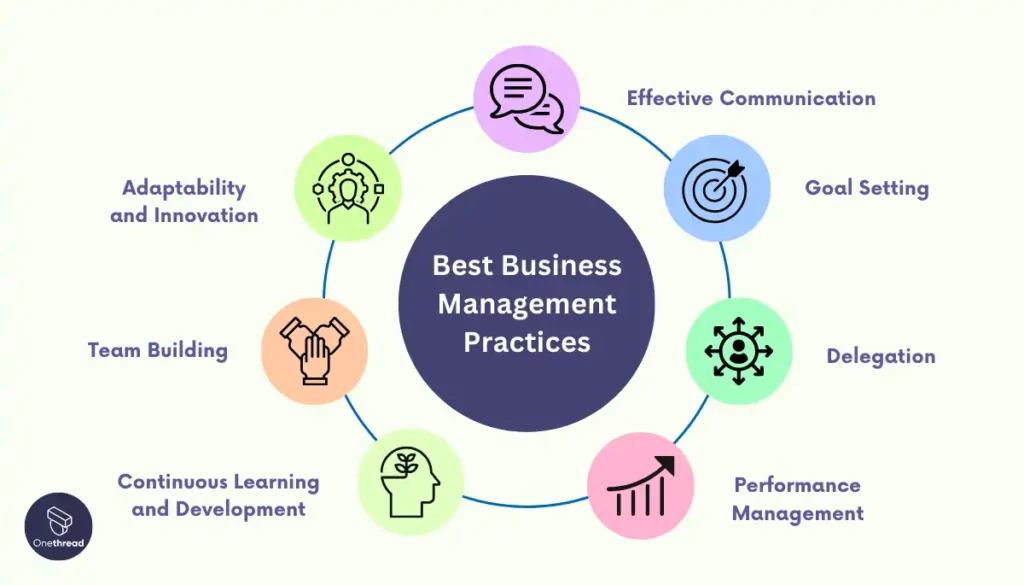
Effective Communication
Clear and open communication is essential for successful management. Managers should listen actively, provide feedback, and ensure that information flows smoothly throughout the organization.
Onethread facilitates clear and open communication through various features like task comments and discussions. This empowers team members to stay informed, share ideas, and collaborate effectively, fostering a culture of transparency and open communication.
Goal Setting
Setting specific, measurable, achievable, relevant, and time-bound (SMART), goals help align efforts and provide a clear sense of direction. Managers should involve employees in the goal-setting process to foster ownership and commitment.
To address this challenge, organizations should assist their employees in grasping several fundamental concepts:
- Purpose: Why does the organization exist?
- Core Activities: What does the organization do?
- Priorities: What is the most important focus at present?
- Roles and Responsibilities: Who is responsible for what?
By answering these questions, business managers gain a clear understanding of the company’s vision, mission, and values.
Business managers play a pivotal role in facilitating the growth and goal attainment of an organization. They employ various strategies and tactics to drive progress and achieve desired outcomes.
Delegation
Delegating tasks and responsibilities empowers employees, builds their skills, and frees up time for managers to focus on strategic initiatives. Effective delegation involves matching tasks with employees’ strengths and providing necessary support.
Onethread’s task management features allow managers to easily assign tasks, set deadlines, track progress, and provide feedback. This empowers employees to take ownership and accountability while freeing up managers’ time for strategic thinking and planning.
Try Onethread
Experience Onethread full potential, with all its features unlocked. Sign up now to start your 14-day free trial!
Performance Management
Establishing performance metrics, conducting regular evaluations, and providing constructive feedback helps employees understand expectations and continuously improve their performance.
Continuous Learning and Development
Encouraging learning opportunities, training programs, and professional development initiatives ensures that employees and managers stay updated with industry trends and enhance their skills.
Team Building
Building strong, cohesive teams promotes collaboration, boosts morale, and improves overall performance. Managers can facilitate team-building activities, encourage open communication, and foster a positive work environment.
Adaptability and Innovation
Business environments are dynamic, and managers should embrace change and encourage a culture of innovation. They should be open to new ideas, promote creative thinking, and adapt strategies as needed.
For those interested in pursuing a career in this field, understanding the key skills and responsibilities associated with business management roles is essential.
Career in Business Management
Business management is a broad field that offers a diverse range of career opportunities across various industries.
To build a successful career in management, having a solid educational foundation is essential. If you’re pursuing a degree in business management and need support with your coursework, seeking assignment help can be a valuable resource to ensure you excel in your studies.
With a degree in business management, you can pursue roles such as client services manager, sales representative, project manager, office manager, human resources manager, business manager, community manager, staff accountant, marketing manager, logistics manager, account executive, data analyst, business consultant, management analyst, development director, and director of operations.
Here’s a table that outlines the roles, their primary responsibilities, and their estimated annual salary-
Role | Primary Responsibilities | Job Outlook, 2022-32 (Growth Rate) | Median Salary (as of May 2022) |
Sales Representative | Contact potential and existing customers, discuss products/services, negotiate contracts, ensure customer satisfaction | No growth | |
Project Manager | Organize, plan, direct and coordinate business projects, ensure adherence to deadlines, budgets, and goals | 6% | |
Human Resources Manager | Oversee hiring, firing, training, and development of employees, handle payroll and benefits, supervise incentive programs | 5% | |
Community Manager | Build and grow online presence, analyze community engagement, develop plans for online interaction | 9% | |
Bookkeeping, Accounting, and Auditing Clerks | Maintain financial reports, records, ledgers, prepare invoices, develop and implement accounting procedures | 6% | |
Marketing Manager | Develop strategies to drive sales and customer acquisition, analyze industry trends, supervise marketing teams | 6% | |
Logistics Manager | Organize goods storage and distribution, coordinate with customs officials, ensure employee safety procedures | 18% | |
Data Analyst | Translate market research or sales data into understandable information, help businesses make informed decisions | 13% | |
Management Analyst | Help organizations maximize efficiency through cost reductions and increased revenue, design more efficient systems | 10% |
These are just some of the career paths you can choose from in business management. There are countless other options available as well for eligible business managers.
Who is A Business Manager?
A business manager is an individual responsible for overseeing and coordinating various aspects of a business to ensure its smooth operation and success. They play a crucial role in managing resources, making strategic decisions, and leading teams to achieve organizational goals.
The specific responsibilities and duties of a business manager can vary depending on the size and nature of the organization. In smaller businesses, a business manager may be involved in a wide range of activities, while in larger organizations, their role may be more specialized.
Top 10 Skills Every Business Manager Should Have
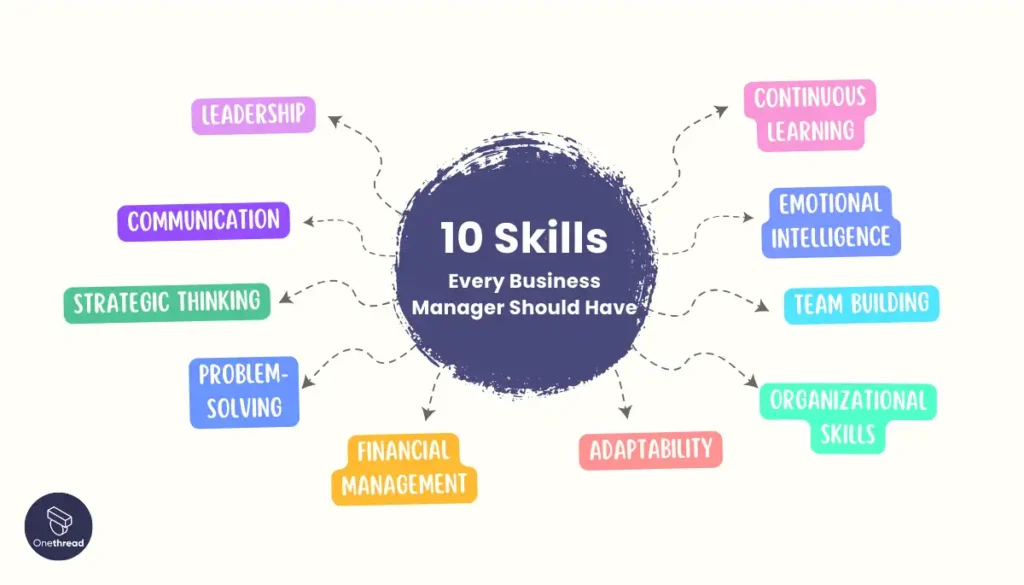
Being a successful business manager requires a diverse set of skills to effectively navigate the complexities of the role. Here are some key skills that every business manager should possess:
Leadership
A business manager should have strong leadership skills to inspire and motivate their team. They should be able to set a clear vision, provide guidance, delegate tasks, and foster a positive work environment.
Communication
Effective communication is crucial for a business manager to convey ideas, expectations, and goals clearly to their team. They should be skilled at active listening, providing feedback, resolving conflicts, and presenting information in a compelling manner.
According to the connected culture report by RingCentral, a staggering 71% of employees experience a heightened sense of productivity when they establish strong connections and foster meaningful relationships with their colleagues.
This statistic underscores the significant impact that a well-connected work environment can have on individual performance and overall team dynamics. So, a business manager must have proper communication with on and off sites.
Strategic Thinking
Business managers need to think strategically to set long-term goals, identify opportunities, and develop plans to achieve organizational objectives. They should be able to analyze market trends, evaluate risks, and make informed decisions that align with the organization’s vision.
Problem-solving
As a business manager, encountering challenges is inevitable. Strong problem-solving skills are essential to identify issues, analyze root causes, and develop creative solutions. They should be adept at critical thinking, decision-making, and managing crises effectively.
Financial Management
Understanding financial principles and practices is crucial for a business manager. They should possess knowledge of budgeting, financial analysis, and forecasting to make informed decisions and ensure the organization’s financial stability.
Adaptability
The business landscape is dynamic, and managers must be adaptable to changing circumstances. They should be open to new ideas, embrace innovation, and be willing to adjust strategies and plans as needed.
Organizational Skills
Business managers need excellent organizational skills to manage their own time effectively and prioritize tasks. They should be able to coordinate and delegate work, set deadlines, and ensure the smooth operation of processes and projects.
Team Building
Building and nurturing a strong team is crucial for a business manager. They should be skilled in recruiting, training, and developing employees. They should also foster a collaborative work environment, promote diversity and inclusion, and encourage teamwork and synergy.
Emotional Intelligence
A business manager should possess the emotional intelligence to understand and manage their own emotions and those of their team members. This skill helps in building strong relationships, resolving conflicts, and promoting a positive work culture.
Continuous Learning
The business landscape is constantly evolving, and successful managers should have a thirst for learning. They should stay updated on industry trends, seek professional development opportunities, and encourage a learning culture within their team.
When honed and applied effectively, these skills can empower business managers to lead their teams, drive success, and achieve sustainable growth for their organizations.
Although the terms “business administration” and “business management” are often used interchangeably, there are distinct differences between the two roles and responsibilities.
Business Administration vs Business Management
Business administration focuses on the day-to-day operations and technical aspects of running a business, like accounting, finance, marketing, and logistics. Business management, in contrast, concentrates more on big-picture leadership and strategy, as well as organizing teams and resources to accomplish goals.
While administration handles practical execution, management oversees planning, communication, and high-level decision-making.
Here is a comprehensive comparison between business management and business administration:
Category | Business Management | Business Administration |
Focus | Organizing and managing a company's resources (including people); Seeing the big picture; Leadership and communication skills | Specialized, technical aspects of business; Nuts and bolts of running a business |
Coursework | Management, HR management, business strategy, decision-making, information systems | Accounting, finance, marketing, economics; Specialized concentrations |
Skills | Motivating employees, delegating, interpersonal communication, vision/mission development | Analytics, attention to detail, methodical, technical skills |
Careers | Operations manager, sales manager, management analyst | Accountant, financial manager, marketing specialist, HR administrator |
Salary (median) | $102,450 | $99,290 |
Job growth | 8% | 7% |
The main differences lie in the focus of each degree – business management concentrates more on leading and organizing people and resources, while business administration provides specialized knowledge in a particular area like accounting or marketing.
Both prepare students for leadership roles, but business managers focus on high-level strategy while administrators handle operational details.
Now, let’s find out how business administration and management differ in different areas in more detail.
Education
Business Management degrees focus more on leadership skills like communicating vision, managing teams, and organizational strategy. Business administration programs, in contrast, specialize earlier in functional areas like marketing, finance, HR, etc.
Administration students take advanced courses in their concentration while management students emphasize leadership theories, HR management, and operations.
Careers
Typical business management careers include executive roles like operations, financial, and management analysts directing strategy. On the other hand, typical business administration careers involve specialized functions like marketing analysis, accounting, and HR coordination.
Typical business management careers:
- Operations Manager
- Management Analyst
- Financial Reporting Manager
- Executive roles directing Strategy, etc.
Typical business administration careers:
- Marketing Analyst
- Accounting
- Finance
- Human Resource Coordinators
- Specialized functional roles, etc.
Skills
Business managers need abilities in motivating and delegating to teams, thinking innovatively, and seeing the big picture. Administrators, in comparison, are more analytical, handle details and specialized tasks, and adapt to rapid change.
Business managers need skills like:
- Motivating and delegating
- Thinking innovatively
- Seeing the big picture
- Strategic planning
- Decision-making authority, etc.
Administrators need skills like:
- Data analysis
- Tracking details
- Methodical execution
- Technical specialization
- Rapid problem-solving
- Adaptability, etc.
Workplace
In the workplace, business managers focus more on influential leadership positions guiding strategy and company vision. On the contrary, business administrators handle essential specialized operations like accounting, logistics, marketing, and data analysis.
Business managers focus on:
- Influential leadership
- Guiding strategy
- Company vision
- High-level decisions, etc.
Administrators handle:
- Specialized operations:
- Accounting
- Marketing
- Logistics
- Data/business analysis, etc.
- Day-to-day execution
Building upon the previous section, let’s further differentiate the roles of a business manager and a business administrator to clarify their distinct responsibilities.
Business Manager vs Business Administrator
Here’s a comparison table highlighting the key differences between a business manager and a business administrator:
Aspects | Business Manager | Business Administrator |
Role and Responsibilities |
|
|
Focus | Strategic planning and execution. | Operational efficiency and coordination. |
Skills and Qualities |
|
|
Examples | CEO, General Manager, Department Manager. | Office Administrator, Executive Assistant, Administrative Coordinator. |
While there may be some overlap in certain tasks and responsibilities, the main distinction lies in the focus and scope of their roles.
A business manager typically has a broader range of responsibilities and focuses on leading and driving the overall success of a business.
They are involved in strategic planning, decision-making, resource management, and leading teams to achieve organizational goals. Examples of business manager roles include CEOs, General Managers, and Department Managers.
On the other hand, a business administrator plays a supportive role in the organization. They assist with administrative tasks to ensure the smooth operation of the business.
This can involve tasks such as record-keeping, scheduling, coordinating meetings, and providing support to managers and departments. Business administrators often possess strong organizational and administrative skills.
Examples of business administrator roles include Office Administrators, Executive Assistants, and Administrative Coordinators.
It’s important to note that the specific roles and responsibilities can vary based on the organization’s size, industry, and structure. Some smaller organizations may use the terms “business manager” and “business administrator” interchangeably or have hybrid roles that encompass both aspects.
Ultimately, while both roles contribute to the efficient functioning of a business, business managers focus more on strategic planning and leadership, while business administrators provide vital support in day-to-day operations and administrative tasks.
FAQs
How can business management contribute to organizational growth?
Effective business management plays a crucial role in driving organizational growth by optimizing operations, maximizing resources, fostering innovation, and aligning strategies with market opportunities. It helps businesses adapt to changing conditions, improve efficiency, and make informed decisions to achieve sustainable growth.
What are common challenges in business management?
Common challenges in business management include competition, risk management, technology adaptation, employee engagement, market fluctuations, and financial stability. Effective strategies and continuous learning help address these challenges.
What are the career opportunities in business management?
Business management offers a wide range of career opportunities. Some common roles include business manager, project manager, operations manager, marketing manager, human resource manager, financial manager, and executive positions such as CEO or general manager. The specific career path depends on the individual’s skills, interests, and the industry they choose to work in.
Can business management principles be applied to different industries?
Yes, business management principles can be applied to different industries. While each industry may have its specific requirements and dynamics, fundamental management principles such as strategic planning, resource allocation, team management, and customer focus are universally applicable. Adaptation and customization based on industry-specific needs are necessary for successful implementation.
How does business management impact employee productivity and motivation?
Effective business management positively impacts productivity and motivation by providing clear expectations, meaningful work, a supportive environment, recognition and rewards, growth opportunities, and open communication. Strong leadership and performance management contribute to high employee engagement.
Conclusion
Business management encompasses a wide range of practices, strategies, and approaches aimed at achieving organizational goals and ensuring the success of a business. It involves effective leadership, strategic planning, resource management, and the ability to adapt to a changing business landscape. Finding reliable web services online requires careful research and comparison to ensure the best fit for your needs.
By leveraging different management styles, adopting best practices, and implementing a well-designed business management system, organizations can enhance their operational efficiency, and employee productivity, and ultimately achieve sustainable growth and success in today’s competitive marketplace.
